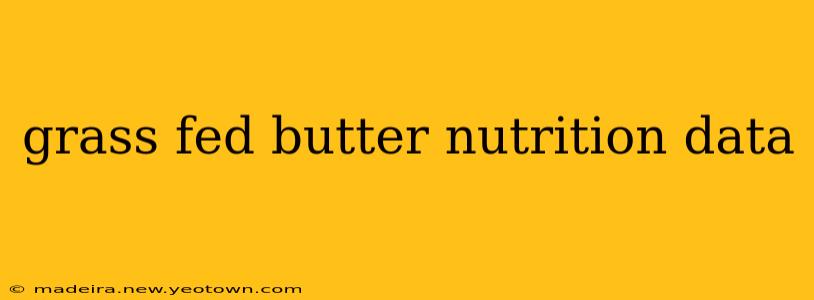The Rich Nutritional Profile of Grass-Fed Butter: A Deep Dive
Butter, a culinary staple for centuries, has recently experienced a resurgence, particularly the grass-fed variety. But what makes grass-fed butter so special, and what are the nutritional benefits? Let's explore this creamy, golden treasure.
Our journey begins on lush green pastures, where contented cows graze freely, their diet consisting primarily of grass and other forbs. This simple difference in diet profoundly impacts the butter's nutritional composition compared to conventionally produced butter.
What are the key nutritional differences between grass-fed and conventional butter?
This is a crucial question, and the answer lies in the cow's diet. Grass-fed cows consume a diet rich in beta-carotene, a precursor to vitamin A. This translates to grass-fed butter boasting significantly higher levels of Vitamin A than its conventionally produced counterpart. Conventionally raised cows, often fed grain-based diets, produce butter with lower Vitamin A content. Furthermore, grass-fed butter tends to have a higher concentration of beneficial fatty acids like conjugated linoleic acid (CLA) and omega-3 fatty acids, which are known for their potential health benefits. These fatty acids are less abundant in butter from cows fed grain-based diets.
Is grass-fed butter higher in fat?
Yes, grass-fed butter, like all butter, is high in fat. However, it's crucial to understand that not all fats are created equal. Grass-fed butter contains a more favorable ratio of saturated to unsaturated fats, and importantly, a higher concentration of healthy fats like CLA and omega-3s mentioned previously. While it's high in saturated fat, the type of saturated fat found in grass-fed butter differs from that found in conventionally produced butter, potentially lessening some negative health impacts associated with saturated fat. It is important to consume butter in moderation as part of a balanced diet.
How much vitamin K2 is in grass-fed butter?
Vitamin K2, a fat-soluble vitamin crucial for bone health and cardiovascular function, is another nutrient where grass-fed butter shines. The exact amount of Vitamin K2 can vary depending on factors such as the cow's breed, diet, and the time of year. However, it's generally accepted that grass-fed butter contains considerably more Vitamin K2 than conventionally produced butter. This is because the cows' diet directly influences the vitamin content of their milk and subsequently, the butter.
What are the health benefits of consuming grass-fed butter?
The increased levels of vitamins A and K2, CLA, and omega-3s in grass-fed butter contribute to a range of potential health benefits. These include improved bone health, reduced risk of heart disease, enhanced immune function, and potentially even anti-cancer properties linked to CLA. However, it's important to remember that more research is needed to definitively confirm these benefits and the extent to which grass-fed butter contributes to them. A healthy diet and lifestyle are always key factors in overall health.
Does grass-fed butter contain more cholesterol?
Grass-fed butter does contain cholesterol, as does all butter. However, the impact of dietary cholesterol on blood cholesterol levels is a complex topic that is still being actively researched. While some people may be more sensitive to dietary cholesterol than others, it’s not necessarily a reason to avoid grass-fed butter completely, particularly when balanced with a healthy overall diet. Focus on overall dietary cholesterol intake and consult your doctor or a registered dietitian for personalized advice.
The story of grass-fed butter is a story of nature's bounty, reflecting the direct link between a cow's diet and the nutritional quality of the food it produces. While it's important to consume it in moderation as part of a balanced diet, grass-fed butter offers a unique nutritional profile that makes it a worthy addition to a healthy lifestyle. Remember to always consult with a healthcare professional before making significant dietary changes.

